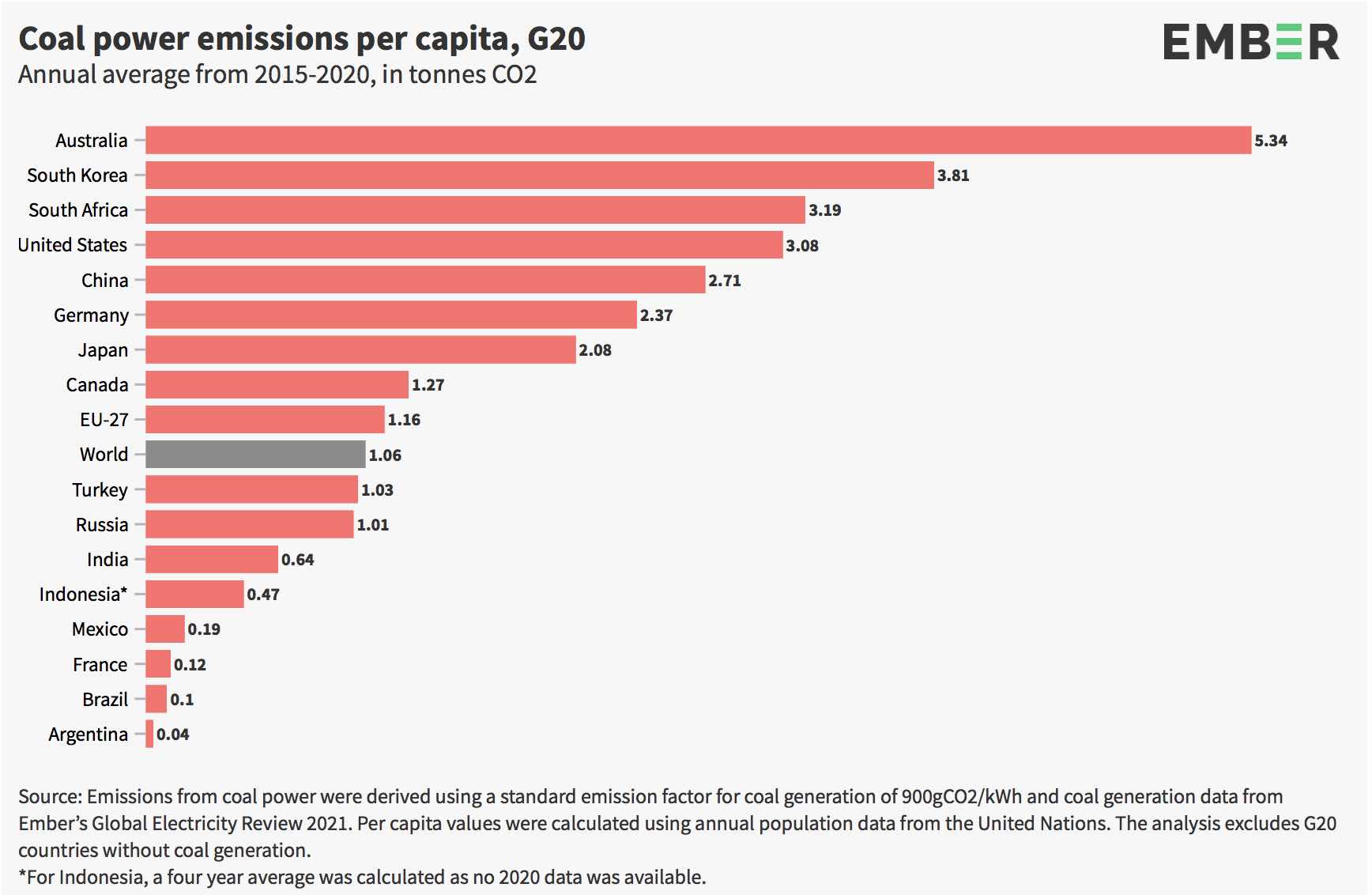New analysis shows that the world’s richest countries are among the worst coal power emitters when you adjust for population size.
Australia has the highest emissions per capita in the world from burning coal for electricity. The average Australian emits 5x more CO2 from coal power than the average person globally.
South Korea and the United States emit almost 4x and 3x the global average respectively, according to research from energy think tank Ember.
The analysis calculates average annual coal power emissions per capita since the Paris Agreement, using electricity generation data from Ember’s Global Electricity Review and annual population data from the United Nations.
Countries within the OECD, including Australia, South Korea, the United States, Germany and Japan, should end coal power by 2030 to align with a 1.5 degree pathway, according to the International Energy Agency’s Net Zero Roadmap.
However, the analysis finds they are among the worst performers on coal power when you adjust for population size.
The new analysis highlights that:
Australia has the highest per capita coal emissions in the G20 – and in the world – at 5.34 tonnes of CO2 per year. The average Australian emits 5x more CO2 from coal power than the average person globally, and almost 2x as much as the average person in China.
South Korea has the second highest per capita coal emissions in the G20 at 3.81 tonnes of CO2 per year. The average Korean emits almost 4x more CO2 from coal power than the global average.
The United States has the fourth highest per capita coal emissions in the G20 at 3.08 tonnes of CO2 per year. The average American emits almost 3x more CO2 from coal power than the global average.
China is the world’s largest coal power consumer and has the fifth highest per capita coal emissions in the G20 at 2.71 tonnes of CO2 per year. The average person in China emits 2.5x more CO2 from coal power than the global average.
The average person in Germany and Japan emits 2x the global average from coal power.
Even though India is the world’s second largest coal power country, the average person in India emits far less than the global average, and only half of what the average Canadian would do through coal power, and 8x less than the average Australian.
Background
Since Paris, the global pipeline of planned coal projects around the world has collapsed, with more than 76% of coal projects cancelled, and now more than 84 countries that previously considered building coal are now heading for coal-free futures.
This trend has also been seen across the OECD, where coal power has halved in the last decade, and over 56% of the OECD ‘s coal capacity has either closed since 2010 or is scheduled to close by 2030. This could rise to 80% if Germany and the US enact potential legislation to phase out coal by 2030.
The UN Climate Summit in Glasgow has ushered in a wave of critical pledges to phase out coal from Indonesia and Vietnam, as well as a key push for India to achieve 50% of its electricity from renewables by 2030, and enhanced collaboration between China and the US.
However, as the UN climate summit comes to a close, this new analysis highlights that regardless of the global momentum away from coal, countries within the OECD remain some of the biggest per capita coal emitters.
Many of the laggard OECD countries, including Australia and Japan, have failed to commit to a coal phase-out date, although they have all pledged to reach Net Zero by 2050 at the latest.
The United States has declined to commit to a coal phase-out deadline, but its target for zero-carbon electricity by 2035 assumes an earlier coal phase-out.
Germany has a 2038 coal exit, but its new coalition government signalled it may look to accelerate to 2030 to align with the Paris Agreement and a 1.5C pathway. South Korea was the only country within this group that signed up to the Coal to Clean pledge at COP26, promising to phase out coal for developed economies in the 2030s.
However, only days later, South Korea’s ministry of energy released a statement arguing that 2030 was “impossible” and that it may not phase out coal until 2050.
Methodology
Emissions from coal power were derived using a standard emission factor for coal generation of 900gCO2/kWh and coal generation data from Ember’s Global Electricity Review 2021. Per capita values were calculated using annual population data from the United Nations.
The values represent the average annual per capita emissions over the period of 2015-2020. Where 2020 data were not available, the average over 2015-2019 was used. The analysis excludes G20 countries without coal generation.
This excludes upstreams emissions from coal mining; at a global level, methane leaks from coal minesadd 23% to the short-term climate impact of burning coal.
This article was originally published on Ember. Reproduced with permission.









